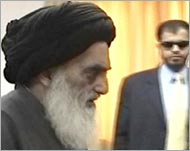Najaf under intense shelling barrage
As US AC-130s and artillery units continued their sixth day of bombing al-Mahdi Army positions in Najaf, Grand Ayat Allah Ali al-Sistani has issued a call for Iraqis to march to the city to “save it from destruction”.

Five explosions were heard early on Thursday morning as artillery fire rained down on al-Mahdi Army holdouts in Najaf.
The artillery fire was followed by what residents said was a warplane attack.
A few hours earlier, two deafening explosions sounded across Najaf late on Wednesday evening, as US warplanes bombed the historic heart of Najaf, witnesses said.
Thick black smoke spewed out into the night sky not far from the revered Imam Ali mausoleum, where supporters of cleric and militia leader Muqtada al-Sadr have been trapped by US occupation forces, an AFP correspondent said.
Witnesses said they saw planes drop two bombs at around 23:15 (19:15 GMT).
An al-Sadr spokesman based in Nasiriya said that all al-Mahdi Army operations in southern Iraq had been suspended as of Wednesday night.
Aws al-Khafaji is also reported to have told AFP that the militia have lost control of major sections of Najaf.
An Iraqi security source also said Iraqi police had arrested al-Sadr aide Ali al-Sumaisim and four office staff near the Thawrat-al-Ishrin square in Najaf.
Al-Sistani’s march
Iranian-born al-Sistani arrived in the southern city of Basra early on Wednesday and called on the march to begin on Thursday.
He is hoping to end the fighting between US forces and followers of his political foe, Shia cleric Muqtada al-Sadr, by breaking up the two sides.
“The Americans have been surrounding the shrine for days and
Sadr’s followers stayed barricaded and determined. This march is the only way for both sides to save face,” said independent
Shia cleric Muhammad Bahr al-Uloum.
“The march will make history. It could be decisive in keeping Iraq united. We can talk politics later,” said Uloum,
who acknowledges Sistani, 73, as the highest living authority in Shia Islam.
 |
|
Sistani arrived in the southern city |
Iranian-born Sistani, who had not left Najaf for years, departed the city two weeks ago to undergo surgery in London, just as fighting flared between al-Sadr’s al-Mahdi Army and US occupation forces.
Iraqi sources have criticised the ailing Ayat Allah for not urging action on Najaf sooner.
“The Ayat Allah is trying to set things right. The popular forces in Iraq have been astonished by his silence over the
American use of brute force, although we understand that as a traditional religious elder he prefers subtlety,” said Ali al-Lami, a Shia politician.
Demonstrators killed
Earlier on Wednesday, Aljazeera reported that 16 men were killed and 102 others wounded during a peaceful demonstration heading towards Najaf.
Video footage from Associated Press Television News showed demonstrators wounded during a few minutes of heavy gunfire.
The marchers chanted slogans in support of al-Sadr and carried pictures of the cleric as well as pictures of al-Sistani.
Witnesses said the gunfire appeared to come from an Iraqi National Guard post, which sat behind concrete blast walls along the demonstration route.